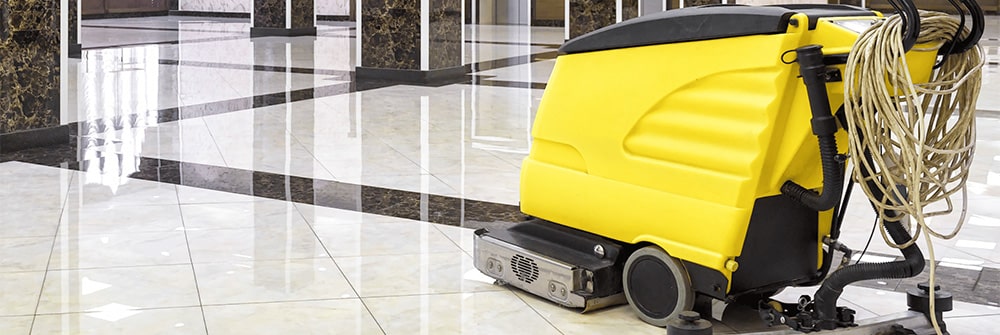
Automatic floor scrubbers tend to be looked at as an investment for many businesses due to the generally high cost of a brand-new model. This makes getting the most out of your floor scrubbing machine as important as possible, to protect the investment and get the most use out of the money you’ve spent. To prolong the lifespan of your floor scrubber, routine maintenance procedures are an excellent idea. You can also avoid costly equipment downtime from service and repairs by ensuring your floor scrubber is in perfect working order. In this post from the Washing Equipment of Texas blog, we’ll discuss some ways you can ensure that your floor scrubber is properly maintained to maximize its lifespan as much as possible.
Tips For Maintaining Your Floor Scrubber Before Use
These are some important things to remember before you use your floor scrubber or sweeper:
Always Check Your Batteries
In most cases, floor scrubbers run on batteries as they operate indoors. Of the common types of batteries used within floor scrubbers, gel, AGM, lithium, and wet flooded are the most prevalent. The maintenance requirements of each battery can differ depending on its manufacturer, so be sure to check your owner’s manual to learn about some maintenance specifics of your battery. But, regardless of the type of battery your machine uses, the following tips ring true:
- Ensure that your battery terminals are free of corrosion
- Confirm that connections are tight and stable
- Maintain the water levels for wet flooded batteries (this should be done weekly)
- And of course; make sure your battery is charged
Check & Clean Debris Tray
Almost all modern automatic floor scrubbers have a built-in debris capture tray. This debris tray is typically reserved for holding smaller items; things such as wrappers, wood chips, and food particles that may have been missed during dust mopping or floor-sweeping. While emptying the debris tray should always be done after the floor scrubber is used, you should make sure that it’s empty before use as well. Some debris like food particles can result in mold and foul smells, while other larger items like wood chips can cause clogging or overflowing of the debris tray.
Inspect Vacuum or Drainage Hoses for Clogs or Leaks
Debris or cracks in the drainage or vacuum hose can easily cause leaks or clogs that impact the performance of the floor scrubber or even disable it entirely. Always backflush the vacuum hose before use, using the port typically found inside the tank and flushing with clean water. Check your owner’s manual for the proper port for vacuum hose backflushing. If you notice cracks in your hoses, you should contact the manufacturer or distributor to get replacement parts immediately.
Tips For Maintaining Your Floor Scrubber After Use
Here’s a checklist of things you should do for maintenance after using your floor scrubber:
Drain & Rinse Recovery and Solution Tanks
Automatic floor scrubbers contain two separate tanks: one for distributing cleaning solution, known as the solution tank, and one for collecting dirty cleaning solution from the floor, known as the recovery tank. Both of these tanks must be emptied, as well as rinsed at the end of each use of your automatic floor scrubber. By forgetting to empty your tank, you can look forward to a disgusting sludge mixture in your recovery tank or the tank that cleans up the dirty solution from the floor. When this sludge dries, it hardens at the bottom of the tank and can be frustratingly difficult to remove. Additionally, even if these tanks are emptied, the odors and grime from the recovery tank can persist if not properly rinsed. Draining and rinsing your solution and recovery tanks are perhaps the most important parts of properly maintaining your floor scrubber.
Store Floor Scrubber With All Tank Lids Open
After draining and rinsing your recovery and solution tanks, you should store them with their lids open. Storing your scrubber with the tank lids open greatly reduces the chances of mold, mildew, or odors from collecting in your tanks by allowing airflow to dry their interiors efficiently.
Clean Squeegee Assemblies & Floor Pads or Brushes
Squeegees are what helps the auto scrubber remove water and cleaning solutions from the floor. Pads and brushes are what do the actual floor scrubbing, which removes dirt and grime. You must ensure that both squeegee assemblies and floor pads and brushes are cleaned, rinsed, and dried after every use.
Most squeegee assemblies are built with corrosive metals that can rust over time when not properly cleaned and dried after use. Additionally, it’s fairly common for dirt to get caught under the squeegee, creating lines, or spots on the floor as it is dragged across.
Pads and brushes can also have dirt ingrained within them, not allowing them to provide the optimal floor scrub. Additionally, by cleaning the pads and brushes of your floor scrubber, you can reduce the possibility of bringing dirt from one room of a facility to another.
Both squeegee assemblies and floor pads or brushes should be stored in the upright position, and not on the ground, to avoid damage and allow them to thoroughly dry and be fully prepared for your floor scrubbers’ next use.
Charge Your Battery
To ensure your floor scrubber is prepared for its next use, make sure to charge the battery after you’ve completed the maintenance steps listed above. Most battery manufacturers recommend only charging your batteries when they have less than 20% charge remaining to preserve the battery’s longevity.
For Floor Scrubbers in Texas and New Mexico, Trust Washing Equipment of Texas
At Washing Equipment of Texas, we offer one of the widest selections of floor scrubbers in Texas and New Mexico for sale or rent. Learn more about floor scrubbers and what models we have available here, or contact us online or over the phone with any questions you may have.






